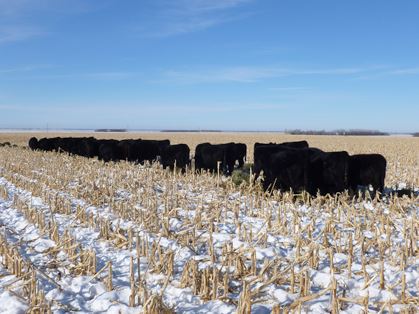



How to Graze Calves on Cornstalks
Cornstalks are under used as a forage option in the Mid West and cut to a main profit factor - winter feeding spend, says a South Dakota beef expert.Grazing cows on corn stalks is a long-standing, common practice to reduce feed costs, writes Warren Rusche, South Dakota State University.

Grazing calves or yearlings on corn stalks is much less commonly done, but does represent an opportunity to produce inexpensive gains, writes Mr Rusche for iGrow, the University's extension service.
Corn stalks are often thought of as low-quality roughage suitable only for cows. However, when cattle are given an opportunity to selectively graze stalks, the diet they select is surprisingly high quality.
Cattle will select any grain first, followed by the husks and leaves; resulting in a diet very similar to prairie hay in composition.
Supplemental sources of protein, phosphorus, Vitamin A, and trace minerals would need to be provided to growing calves to support acceptable levels of performance. Distillers grains work well as a supplemental feed for calves grazing corn stalks.
Calves have gained between 1.5 and 2.0 pounds per day when supplemented with 3-6 pounds of DDGS.
Because DDGS are relatively high in phosphorus, no additional phosphorus would need to be provided in this situation.
Free choice mineral containing salt, additional calcium, trace minerals, and Vitamin A should be provided free choice. Other high-protein feeds could be used as well.
Figure 1. shows replacement heifers being developed in NE South Dakota on corn stalks while being supplemented with 7 pounds of alfalfa per head per day. Supplements should be selected on the basis of cost per unit of delivered nutrients.
How Many Calves Can Be Grazed On An Acre of Corn Stalks?
The supply or residue varies with the grain yield. There’s approximately 15 pounds of husks and leaves for every bushel or corn, so if a field yields 160 bushels per acre that would mean there would be about 2400 pounds of husks and leaves available.
The estimated utilization rate is 50 per cent because of trampling loss and other disappearance, resulting in about 1200 pounds of consumed residue. That would be enough forage for 100 days for a 550 pound calf.
Because residue digestibility declines with time, stocking a field of 160 bushel production with two calves per acre should provide enough residue for 50 days.
Increased stocking rates would tend to depress performance compared to lower stocking rates. This system is well suited for winter-feeding calves that are intended to go to grass next summer and for developing replacement heifers.
High rates of gains aren’t required in those systems; keeping winter feed expenses to a minimum plays a greater role in profitability.
Research data from SDSU suggests that replacement heifers that spend at least some time grazing post-weaning adapt better to grazing later in their life compared to heifers that are strictly developed in the drylot.
Other Provisions
There are some additional cattle management factors that need to be considered. Water for the cattle needs to be provided, which can be challenging as temperatures drop below freezing.
There also needs to be some sort of handling facility nearby to accommodate treatment of sick cattle. Fields that have some form of shelter from wind are much better suited for calves to graze compared to those that are more open, especially as autumn begins to turn to fall. It’s not uncommon to find corn fields located right next to feedlot pens.
These would be ideal situations for grazing calves; water supplies and handling facilities are close, supplemental feed could be fed easily, and if weather dictates that grazing needs to end the calves could be simply be locked into the pens.
Conclusion
Crop residue represents a tremendous untapped resource to produce beef in this region. Under the right circumstances grazing corn stalks can be extremely cost competitive as part of a backgrounding program.



